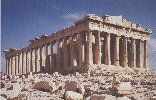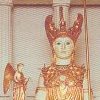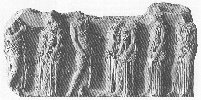

 The Parthenon, or the Temple of Athena Parthenos, in Athens, Greece was built between 447 and 438 B.C. The structure was built on the Acropolis along with four other buildings: the Propylaia, the Erechtheion and the Temple of Athena Nike. The Parthenon was the centerpiece of the plan of the Acropolis and was designed by architects Iktinos and Kallikrates. All sculpture decorating and inside the building was the work of Phidias.
The Parthenon, or the Temple of Athena Parthenos, in Athens, Greece was built between 447 and 438 B.C. The structure was built on the Acropolis along with four other buildings: the Propylaia, the Erechtheion and the Temple of Athena Nike. The Parthenon was the centerpiece of the plan of the Acropolis and was designed by architects Iktinos and Kallikrates. All sculpture decorating and inside the building was the work of Phidias.
 The building itself is a work of art and is regarded by some as the most perfect building ever built. The lines of the temple that appear straight are in actuality curved upward creating a shallow dome. The reason for this irregularity is because a long straight line will appear to sag in the center. The four outside columns are thicker around than the rest, and lean slightly inward. There is also less space between the outside columns and the columns next to them. The reason for these irregularities is because an outside column will be surrounded in light, and will appear thinner than the rest of the columns if it is made the same width. The Parthenon is built in classic Doric order with Ionic elements. It is speculated that the reason for the mixing of these two styles is because the Doric order was a more popular architectural style on the mainland of Greece, where Athens is located, and the Ionic order was more popular on the islands and in Asia Minor (then part of Greece).
The building itself is a work of art and is regarded by some as the most perfect building ever built. The lines of the temple that appear straight are in actuality curved upward creating a shallow dome. The reason for this irregularity is because a long straight line will appear to sag in the center. The four outside columns are thicker around than the rest, and lean slightly inward. There is also less space between the outside columns and the columns next to them. The reason for these irregularities is because an outside column will be surrounded in light, and will appear thinner than the rest of the columns if it is made the same width. The Parthenon is built in classic Doric order with Ionic elements. It is speculated that the reason for the mixing of these two styles is because the Doric order was a more popular architectural style on the mainland of Greece, where Athens is located, and the Ionic order was more popular on the islands and in Asia Minor (then part of Greece).
 The Doric order is the simplest of the Greek architectural orders. Greek orders can best be identified by the type of capitals on the columns. A Doric capital is extremely simple and the column has no base. The entablature is characterized by a series of triglyphs and metopes on the frieze. Usually, the metopes are decorated with a panel of relief sculpture. The pediments were also decorated with sculpture.
The Doric order is the simplest of the Greek architectural orders. Greek orders can best be identified by the type of capitals on the columns. A Doric capital is extremely simple and the column has no base. The entablature is characterized by a series of triglyphs and metopes on the frieze. Usually, the metopes are decorated with a panel of relief sculpture. The pediments were also decorated with sculpture.
The Ionic order is best recognized by its capital with volutes. The column has a base, but the frieze on the entablature is not decorated with triglyphs and metopes. Instead, the frieze is usually decorated with a continuous sculpture. Although there are exceptions to the rule, pediments remained unadorned with any type of sculpture.
 The Parthenon combines these two orders by having the appearance at first of being a Doric temple. The outside columns are the traditional Doric style with their plain capitals and stocky appearance. The entablature contains the Doric elements of alternating triglyphs and metopes. The metopes are decorated with relief sculpture and the pediments each contain sculpture. However, the inner frieze around the top of the cella was continuous as in an Ionic temple. The cella contains a two-story Doric colonnade around Phidias's Athena statue, but the back room uses four Ionic columns to support the structure. With the mixing of these two architectural styles, the Athenians were sending a message that they were the leader of all Greeks.
The Parthenon combines these two orders by having the appearance at first of being a Doric temple. The outside columns are the traditional Doric style with their plain capitals and stocky appearance. The entablature contains the Doric elements of alternating triglyphs and metopes. The metopes are decorated with relief sculpture and the pediments each contain sculpture. However, the inner frieze around the top of the cella was continuous as in an Ionic temple. The cella contains a two-story Doric colonnade around Phidias's Athena statue, but the back room uses four Ionic columns to support the structure. With the mixing of these two architectural styles, the Athenians were sending a message that they were the leader of all Greeks.
 Each side of the temple's metopes depicts an important battle in Greek history that showed the triumph of civilization over barbarism, of order over chaos, and of Athens over Persia. The recent defeat of the Persians by the Athenian army was most likely what caused its citizens to believe that they were the saviors of Greece. On the west pediment of the temple, was the depiction in sculpture of Athena's birth. On the east pediment, was the story of how Athena became the patron deity of the city in a contest with Poseidon.
Each side of the temple's metopes depicts an important battle in Greek history that showed the triumph of civilization over barbarism, of order over chaos, and of Athens over Persia. The recent defeat of the Persians by the Athenian army was most likely what caused its citizens to believe that they were the saviors of Greece. On the west pediment of the temple, was the depiction in sculpture of Athena's birth. On the east pediment, was the story of how Athena became the patron deity of the city in a contest with Poseidon.
 The statue of the goddess Athena that originally stood in the cella of the Parthenon disappeared a very long time ago. We know what the statue looked like from Greek and Latin authors and from Roman copies. The statue was thirty-eight feet tall and was made of gold and ivory. Athena was armed with a shield, spear, and helmet, and held in her right hand Nike, the goddess of victory.
The statue of the goddess Athena that originally stood in the cella of the Parthenon disappeared a very long time ago. We know what the statue looked like from Greek and Latin authors and from Roman copies. The statue was thirty-eight feet tall and was made of gold and ivory. Athena was armed with a shield, spear, and helmet, and held in her right hand Nike, the goddess of victory.
 Panathenaic Festival is what many scholars believe is depicted on the Parthenon's inner Ionic frieze. If this is in fact the case, it shows how high Athenians regarded themselves to include their portraits as part of their most important temple's decoration. The Festival started out in the marketplace and ended on the Acropolis. People brought gifts for Athena such as animals and wreaths. All the gods and goddesses sat and looked on. The fact that the Athenians saw it as important to depict themselves in the temple's decoration shows that the Parthenon was built to honor Athens, the Athenians, as well as their goddess Athena.
Panathenaic Festival is what many scholars believe is depicted on the Parthenon's inner Ionic frieze. If this is in fact the case, it shows how high Athenians regarded themselves to include their portraits as part of their most important temple's decoration. The Festival started out in the marketplace and ended on the Acropolis. People brought gifts for Athena such as animals and wreaths. All the gods and goddesses sat and looked on. The fact that the Athenians saw it as important to depict themselves in the temple's decoration shows that the Parthenon was built to honor Athens, the Athenians, as well as their goddess Athena.
 The Parthenon still exists today, but is pretty much in ruins. Athens has had such a long and diverse history, that it is hard to keep a temple to an ancient deity intact. The structure has been a Byzantine church, a Catholic church, and during the time of the Ottoman Empire, was an Islamic mosque. With each change of religion, the building was modified somewhat. In 1687, when the Venetians were attacking the Turks on the Acropolis, one of their rockets directly hit the Parthenon where the Turks thought it would be a good idea to store some ammunition. This resulted in most of the center of the building being blown to bits. The Venetians then decided that they should remove some of the sculpture, and in more than one case statues were simply dropped to the ground. In the early 1800's, a man known as Lord Elgin, the British ambassador to the Ottoman court at Istanbul, was allowed to remove most of the sculptures and ship them to England. The best preserved of the Parthenon's marbles can today be seen in the British Museum in London.
The Parthenon still exists today, but is pretty much in ruins. Athens has had such a long and diverse history, that it is hard to keep a temple to an ancient deity intact. The structure has been a Byzantine church, a Catholic church, and during the time of the Ottoman Empire, was an Islamic mosque. With each change of religion, the building was modified somewhat. In 1687, when the Venetians were attacking the Turks on the Acropolis, one of their rockets directly hit the Parthenon where the Turks thought it would be a good idea to store some ammunition. This resulted in most of the center of the building being blown to bits. The Venetians then decided that they should remove some of the sculpture, and in more than one case statues were simply dropped to the ground. In the early 1800's, a man known as Lord Elgin, the British ambassador to the Ottoman court at Istanbul, was allowed to remove most of the sculptures and ship them to England. The best preserved of the Parthenon's marbles can today be seen in the British Museum in London.
The Parthenon © 2001 Leslie Norwood